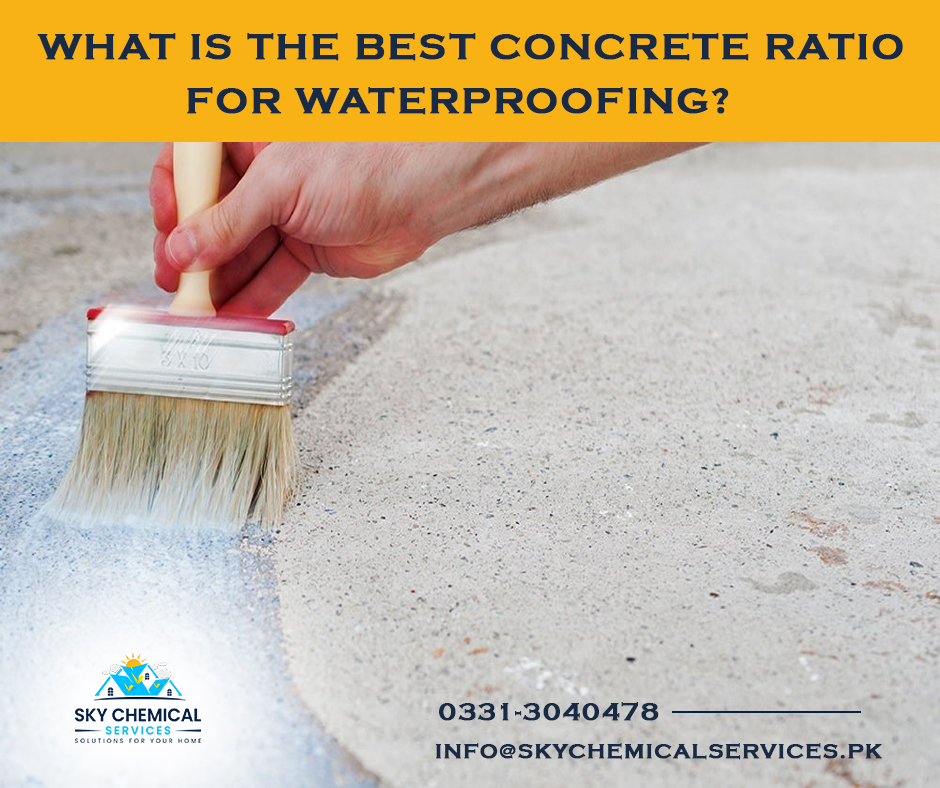
A concrete ratio (mix) comprises water, sand, aggregate gravel, and cement. This Concrete Ratio for Waterproofing is important for several reasons: It controls the mechanical properties and durability of concrete. Moreover, the material’s architecture type and blended patterns are also affected. There are three types of concrete mix ratios:
- Nominal concrete mix ratio
- Standard concrete mix ratio
- Design mix ratio for concrete
According to the proportioning aggregate principle, the smaller particles can occupy the spaces between the large particles. For a good concrete mix, a minimum amount of cement per volume (unit) is required.
When creating a durable and water-resistant structure, the concrete ratio is deemed important. However, there no single unanimous ratio for waterproofing that suits every situation due to changing parameters of the raw materials. Here are some key considerations to understand when determining the concrete ratio:
Water-to-Cement Ratio (w/c)
The water-to-cement ratio is a critical factor in achieving water resistance. Generally, a lower w/c ratio produces a denser and impermeable concrete. It is recommended to use a ratio of 0.45 to minimize water permeability and maintain concrete hydration while reducing the pore spaces.
It is calculated by dividing the water in 1 yd3 of the mix (in lbs.) with the cement (in lbs.) For example, if there is 200 lbs. of water and 400 lbs. of cement, the mix is 0.50 (water-to-cement).
Read More
Which Cement is used for Roof Treatment?
What is the Best Waterproofing for Concrete?
Advantages of Expansion Joint Treatment in Buildings
Cementitious Materials
Using cementitious materials, such as cement, fly ash, or silica fume, can improve the moisture resistance of concrete. These materials fill the voids in the mixture, making it denser and less permeable. Adding supplementary cementitious materials to replace a portion of the cement can also enhance the durability and waterproofing properties of the concrete.
Aggregate Grading
The grading and aggregate size in the concrete mix can affect its water resistance. Well-graded aggregates help to create a compact structure, reducing the pathways for water to penetrate. Using a combination of coarse and fine aggregates in the correct proportions can enhance structural integrity and compactness.
Admixtures
Incorporating waterproofing admixtures into the concrete blend enhances the water-resistance property. These admixtures work by restricting the pore size and creating a hydrophobic barrier within the concrete. Common waterproofing admixtures include hydrophobic agents, crystalline and pore-blocking admixtures, etc. These blends are used to seal the capillary pores and micro-cracks in the concrete, enhancing its water-resistant properties.
Read More
How Construction Chemical Services Helps in Your Project in Karachi?
Top 5 Admixture Companies in Pakistan
What is the role of Admixture Companies in Karachi?
Proper Curing & Adhesion
Strong adhesion helps to eliminate voids and air pockets, improving the density of the concrete. Likewise, a suitable curing process allows for hydration to continue, enhancing the concrete’s strength for years to come. On the other hand, if moisture moves out of the concrete, cracks and ruptures begin to appear.
Brief Study of Mixing Ratios
| Type of Concrete | Cement: Sand: Aggregate | Uses |
| Ready-Mix-Concrete (RMC) | 1:2:4 | Premises |
| High-Strength Concrete | 1:1.5:2.5 | Buildings |
| Modern Concrete | 1:3:6 | Houses/Plazas |
| Plain Concrete | 1:2:4 | Roads, Sidewalks |
| Shotcrete | 1:4 | Ships, Bridges, Repair |
It’s important to note that specific concrete ratio for waterproofing may vary depending on the project requirements, use of the structure, and environmental conditions. Consulting with a structural engineer or concrete expert is essential for determining the most suitable concrete mix for waterproofing applications. Connect with Sky Chemical Services for best results.
Achieving water-resistant concrete involves optimizing the water-to-cement ratio, using suitable cementitious materials, selecting appropriate aggregate grading, incorporating waterproofing admixtures, and implementing proper compaction and curing techniques. By considering these factors and tailoring the concrete mix, it is possible to create durable and water-resistant structures that can withstand the environmental challenges.
